
- Cerro Tololo
- Rubin Observatory
- Science News
- Education Resources
- For Employees
- US-ELTP Resource Center
- How to Apply
- Job Opportunities
- AURA-Spanish
- Cerro Tololo Observatory
- NSF NOIRLab
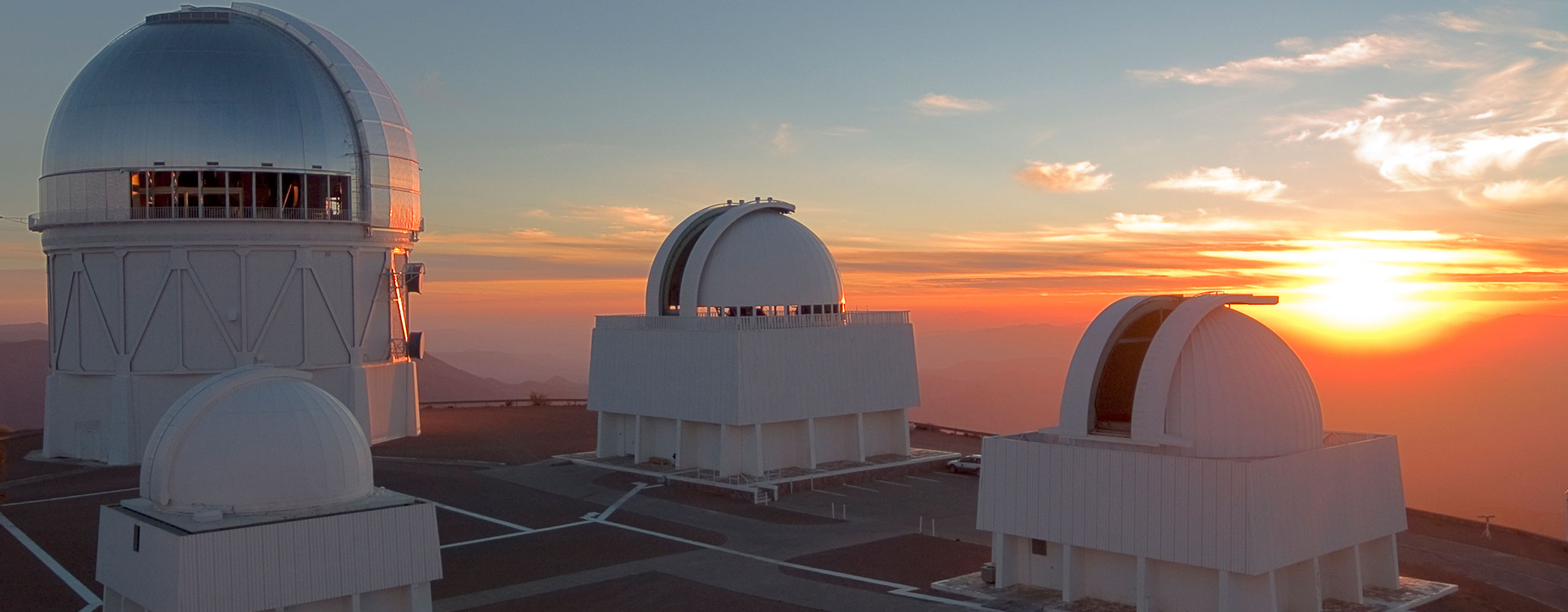

From the first observations in 1965, Cerro Tololo, located in Chile, has served as the principal platform for U.S. astronomical investigation of the southern skies.
Cerro Tololo Inter-American Observatory (CTIO), a program of the NSF NOIRLab, is a complex of astronomical telescopes and instruments located approximately 500km (310 miles) north of Santiago, and 80 km (50 miles) to the east of La Serena, Chile, at an altitude of 2200 meters (7200 feet).
CTIO operates the 4.0-meter Blanco telescope on Cerro Tololo which features the Dark Energy Camera (DECam), a high-performance, wide-field CCD imager built to carry out the Dark Energy Survey (DES) (a US Department of Energy Office of Science-led project). It also operates the 4.1-meter Southern Astrophysical Research (SOAR) Telescope on the adjacent Cerro Pachón (a partnership between Ministério da Ciência, Tecnologia, Inovações e Comunicações Brazil, NSF NOIRLab, the University of North Carolina at Chapel Hill and Michigan State University). The Cerro Tololo 1.5-meter and 0.9-meter telescopes are being operated by the SMARTS Consortium with support from CTIO. Cerro Tololo also hosts 11 tenant observatories and research projects, operating more than 20 telescopes, providing a platform for access to the southern hemisphere for US and worldwide scientific research.

CTIO is operated by NSF NOIRLab, which is managed under a cooperative agreement with the U.S. National Science Foundation by the Association of Universities for Research in Astronomy (AURA).
Visit the Cerro Tololo Website

español | english
Visit to the Cerro Tololo Observatory

The Cerro Tololo Interamerican Observatory (CTIO) is a complex of telescopes and astronomic instruments located in the Elqui Valley at an altitude of 2.200 above sea level. It is operated by AURA, the Association of Universities for the Research in Astronomy, in cooperation with Universidad de Chile and under the auspices of the Chilean Ministry of Foreign Affairs.
Accompanied by Spanish-or English-speaking guides, you will visit the complex, learn about the history of the observatory, the operation of the telescopes and the work done by the researchers.
Cerro Tololo Observatory also has a visitor’s centre, where photos taken through the telescopes of fascinating space phenomena are exhibited.
- Round trip transfer fromLa Serena, Vicuña orPiscoElqui.
- Guide (Spanish or English-speaking)
8:00 am- 2:00 pm. ONLY Saturdays
CLP 120.000 per trip 1 to 4 persons CLP 160.000 per trip 5 to 10 persons CLP 200.000 per trip 11 to 15 persons
Please contact us in case of a larger group size
Social Networks

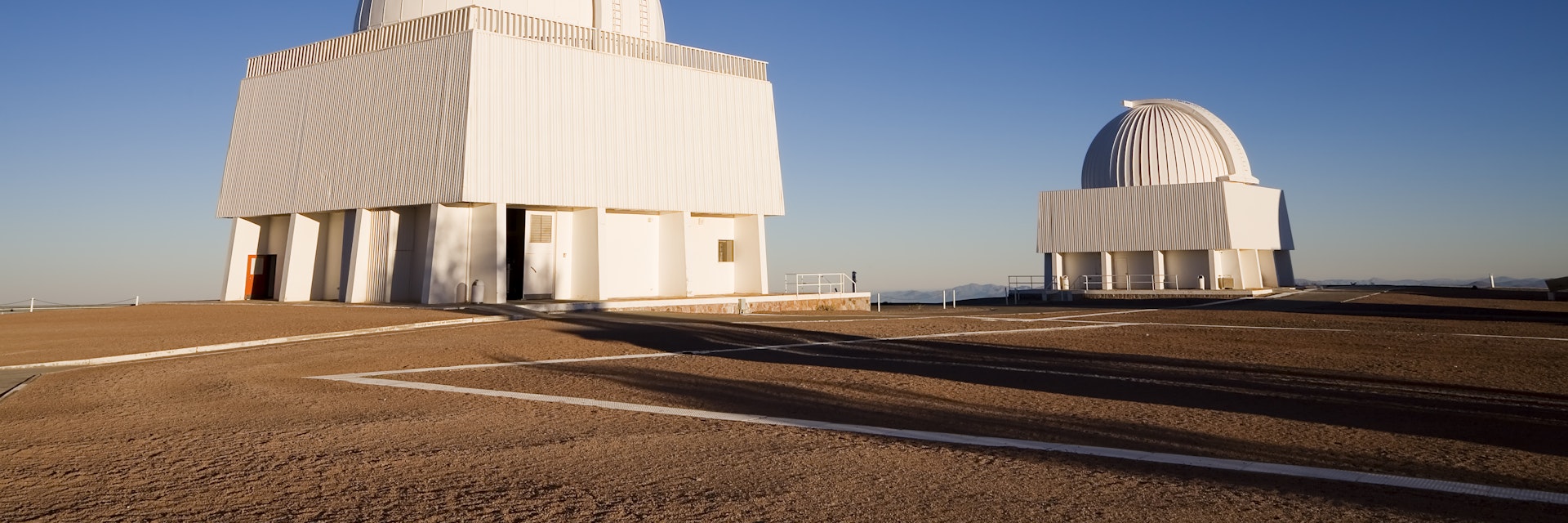
Getty Images/iStockphoto
Observatorio Interamericano Cerro Tololo
Elqui Valley
Probing the mysteries of stars billions of miles into the past is all in a night's work at the futuristic Observatorio Interamericano Cerro Tololo, which sits at 2200m atop its hill. And while visitors can't stargaze through its monstrous telescopes (even the astronomers don't do that as the telescopes first feed data into computer monitors), a daytime tour of the facilities is still an enlightening experience.
Operated by the Tucson-based Association of Universities for Research in Astronomy (AURA, a group of about 25 institutions, including the Universidad de Chile), Tololo has an enormous 4m telescope. Free bilingual tours take place on Saturday only; make reservations at least one month ahead in high season. Two-hour tours are held at 9am and 1pm. There is no public transportation so rent a car or taxi, or arrange to come with a tour operator (you'll still need to make your own reservations with the observatory). After making reservations, pick up a permit to visit the facility from their administrative office in La Serena.
Cerro Tololo
Get In Touch
51-220-5200
https://www.ctio.noao.edu
Lonely Planet's must-see attractions

Cervecería Guayacan
14.23 MILES
You won't get far in the Elqui Valley without someone offering you a Guayacan, and if you're even vaguely interested in beer, you should accept. This…
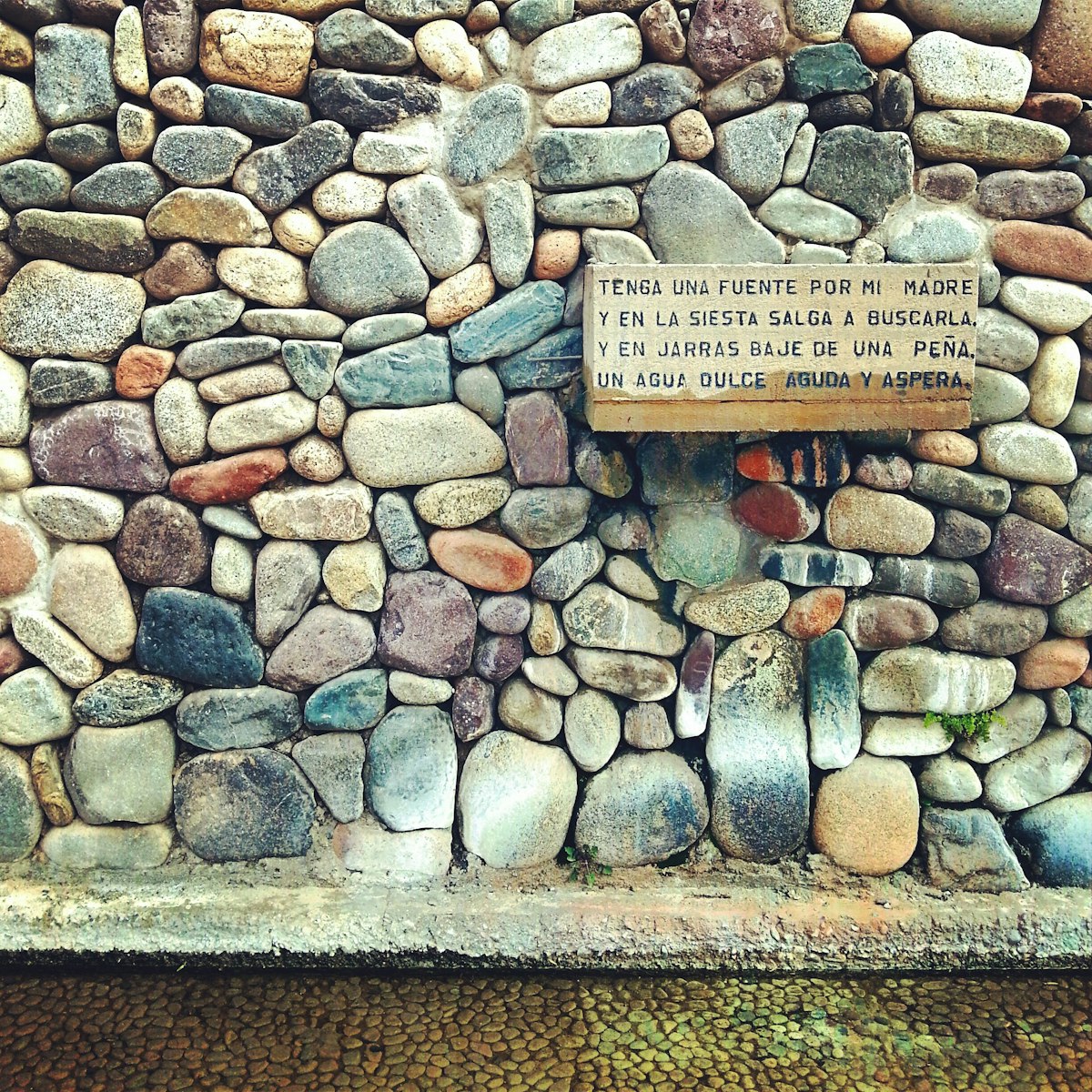
Museo Gabriela Mistral
11.11 MILES
The town's landmark Museo Gabriela Mistral, between Riquelme and Baquedano, celebrates one of Chile's most famous literary figures. Gabriela Mistral was…
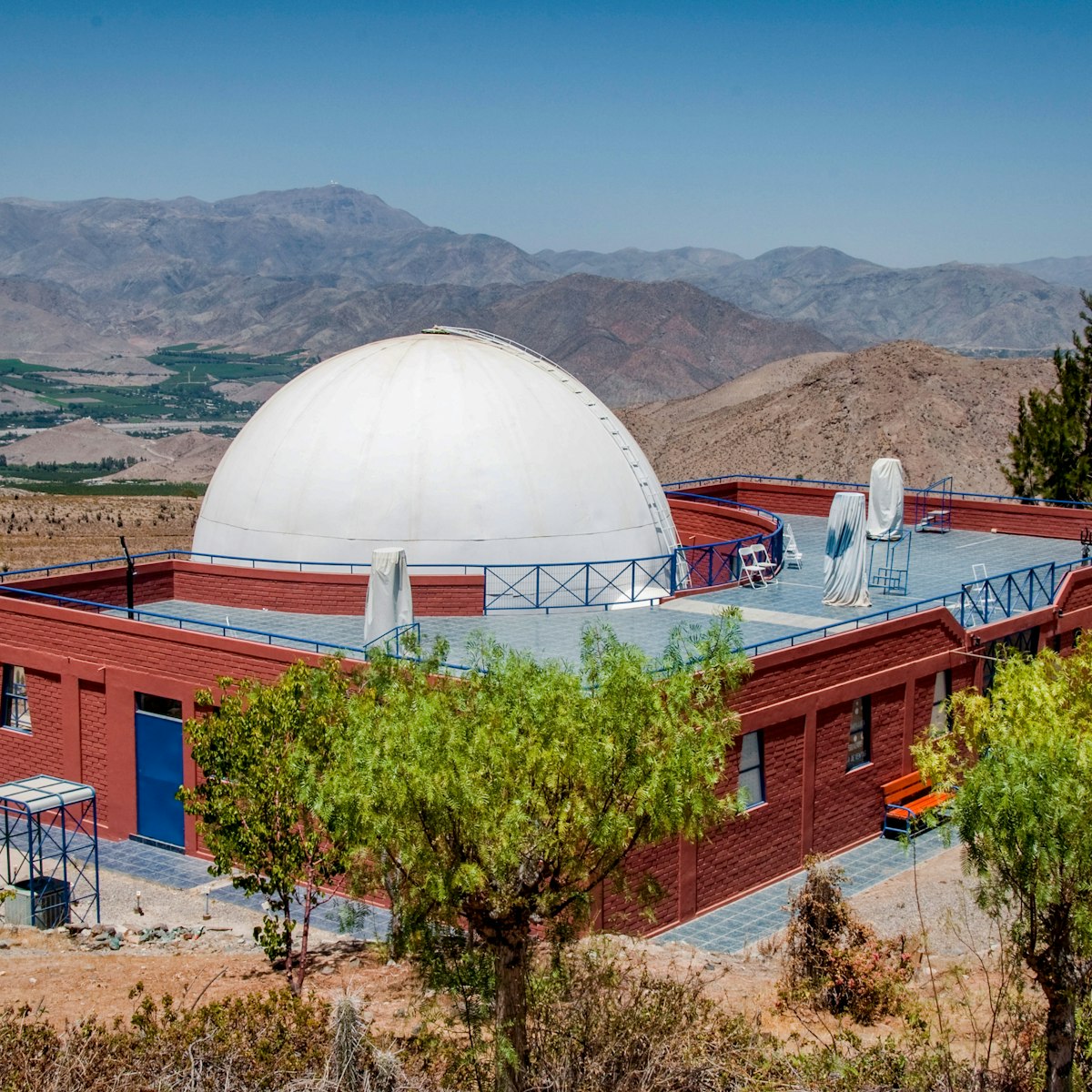
Observatorio Cerro Mamalluca
16.77 MILES
The star of the stargazing show, the purpose-built Observatorio Cerro Mamalluca, 9km northeast of Vicuña, is Elqui Valley's biggest attraction. So big, in…
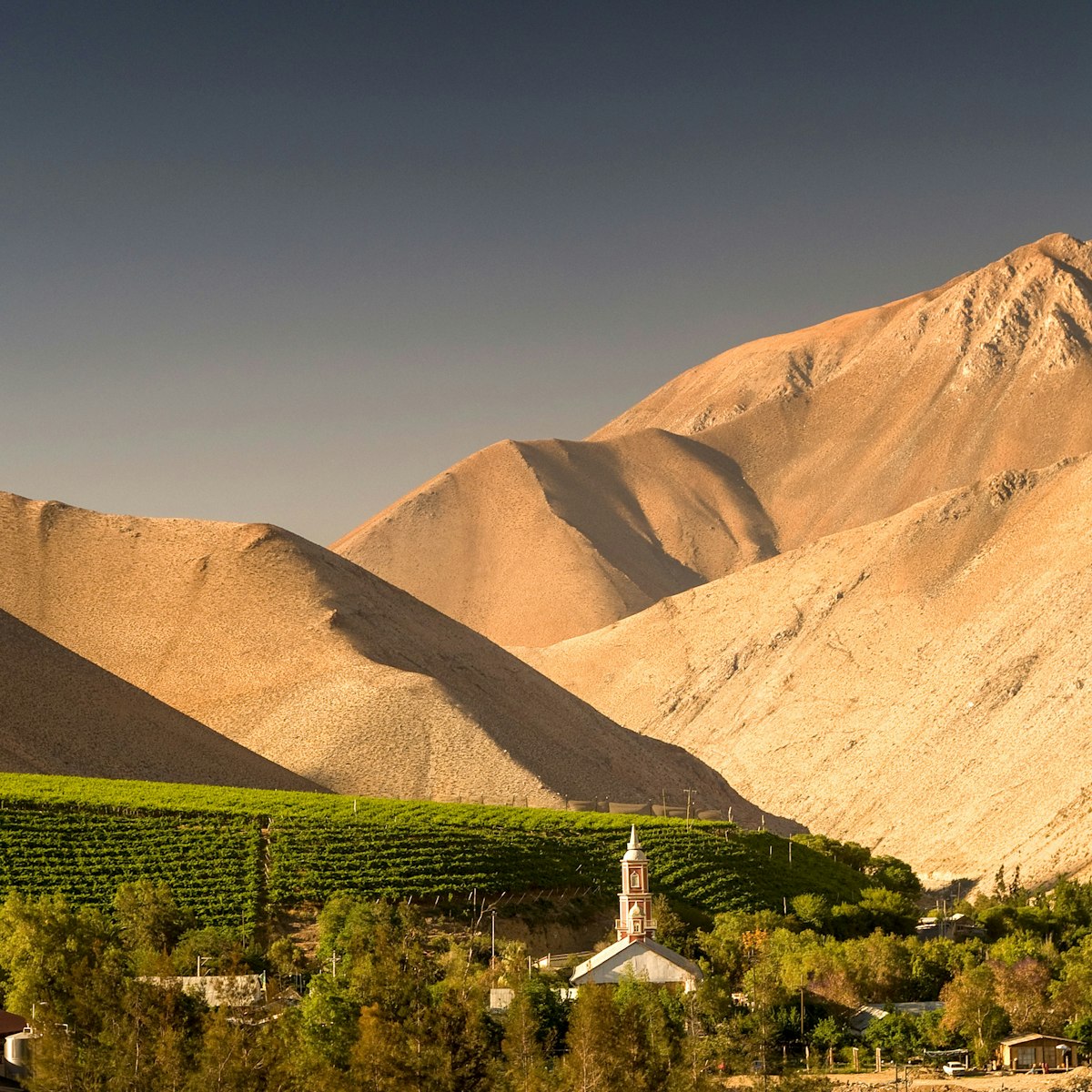
Mausoleo Gabriela Mistral
19.19 MILES
The gravesite of Gabriela Mistral lies on a hillside just south of Montegrande's main plaza. A winding path to the top is lined with quotes and…

Observatorio Collowara
14.83 MILES
Like Mamalluca, the shiny hilltop Observatorio Collowara in Andacollo is built for tourists; no serious interstellar research is conducted here. Two-hour…

Planta Pisco Capel
11.33 MILES
Capel distills pisco at this facility and has its only bottling plant here. Located about 2km (a 20-minute walk) southeast of town, this large pisco maker…

Centro Otzer Ling
A Buddhist stupa in a remote corner of northern Chile? You'll think you took a wrong turn off the Panamericana and somehow ended up in the Himalaya rather…

Observatorio del Pangue
The latest of a few on the observatory front is Observatorio del Pangue, 17km south of Vicuña, run by three enthusiastic French and Chilean astronomers…
Nearby Elqui Valley attractions
1 . Observatorio del Pangue
2 . Museo Entomologico e Historia Natural
10.85 MILES
On the south side of the plaza, this small, one-room museum has an eye-catching collection of fierce-looking scarab beetles, shimmering blue-winged morpho…
3 . Museo Gabriela Mistral
4 . Planta Pisco Capel
5 . Pisquera Aba
12.62 MILES
This family-run boutique pisquera, in operation since 1921, offers quite a different view of pisco production. The 40-minute tours take you through all…
6 . Cervecería Guayacan
7 . Observatorio Collowara
8 . Observatorio Cerro Mamalluca
Cerro Tololo Inter-American Observatory

Top ways to experience nearby attractions

Most Recent: Reviews ordered by most recent publish date in descending order.
Detailed Reviews: Reviews ordered by recency and descriptiveness of user-identified themes such as wait time, length of visit, general tips, and location information.
Also popular with travelers
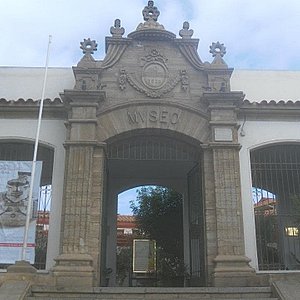
Cerro Tololo Inter-American Observatory - All You Need to Know BEFORE You Go (2024)
- (9.51 mi) Casa Ollagua
- (9.95 mi) Domos Rucka-Inn
- (9.71 mi) Refugio el Colorado
- (7.49 mi) Vicuna Eclipse, Camping & Glamping
- (8.63 mi) casaelqui es un alojamiento vacacional con casona, piscina y acceso a rio
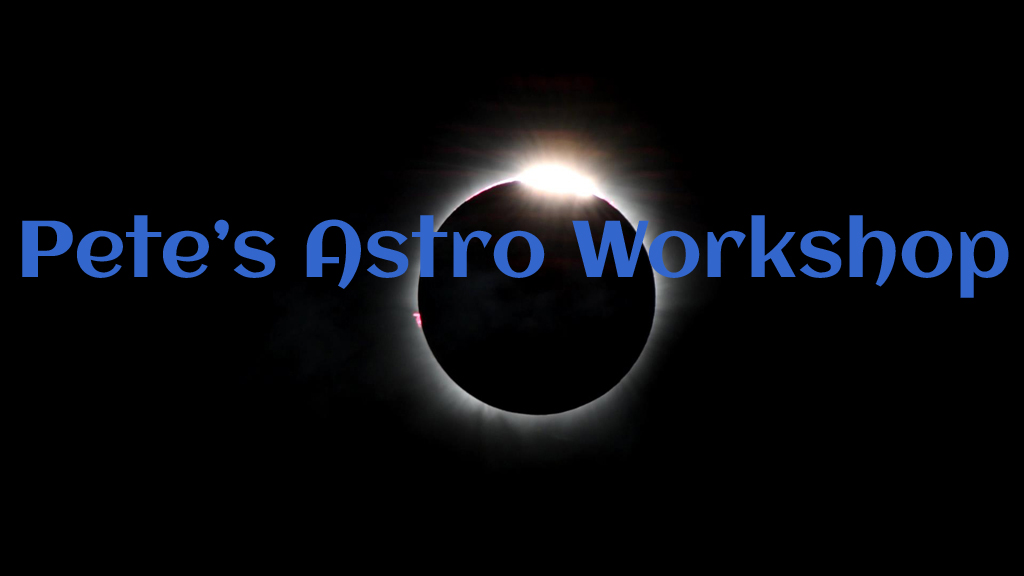
Cerro Tololo Inter-American Observatory
Situated about 30 miles inland of La Serena in Chile, on a 7,000 foot mountain in the Andes, this observatory is home to several telescopes. The most famous is the Victor Blanco 4-meter (158 inch) reflector which has been at the cutting edge of astronomy since the mid-1970s.


Smaller scopes
The dome on the left houses the 1.5m (59-inch) Cassegrain telescope which dates from 1968. The others contain smaller instruments.

The view through the eyepiece of the telescope is breathtaking. Like tiny diamonds on black velvet, countless sparkling stars float against a fathomless backdrop of empty space. “This is Omega Centauri,” says astronomer Alain Maury, who runs a popular tourist observatory just south of San Pedro de Atacama in northern Chile. “To the naked eye, it looks like a fuzzy star, but the telescope reveals its true nature: a huge, globular cluster of hundreds of thousands of stars, almost 16,000 light-years away.” I could take in this mesmerizing view for hours, but Maury’s other telescopes are trained at yet more cosmic wonders. There’s just too much to see.
Chile is an astronomer’s paradise. The country is justly famous for its lush valleys and snowcapped volcanoes, but its most striking scenery may be overhead. It is home to some of the finest places on Earth to enjoy the beauty of the starry sky. If there’s one country in the world that really deserves stellar status, it’s Chile.
If you live in a city, as I do, you probably don’t notice the night sky at all. Yes, the moon is visible at times, and maybe you can see a bright planet like Venus every now and then, but that’s about it. Most people are hard-pressed to recognize even the most familiar constellations, and they’ve never seen the Milky Way.
Not so in Chile. A narrow strip of land, 2,700 miles long and 217 miles at its widest point, Chile is tucked between the Andes Mountains to the east and the Pacific to the west. It stretches from the arid Atacama Desert in the north to the stark granite formations of the Torres del Paine National Park in the south. Large parts of Chile are sparsely populated, and light pollution from cities is hardly a problem. Moreover, the northern part of the country, because of its dry desert atmosphere, experiences more than 200 cloudless nights each year. Even more important to stargazers, Chile provides a clear view of the spectacular southern sky, which is largely invisible from countries north of the Equator.
Long before European astronomers first charted the unknown constellations below the Equator, just over 400 years ago, the indigenous people of Latin America knew the southern sky by heart. Sometimes their buildings and villages were aligned with the heavens, and they used the motions of the sun, the moon and the stars to keep track of time. Their night sky was so brilliant that they even could recognize “dark constellations”— pitch-black, sinuous dust clouds silhouetted against the silvery glow of the Milky Way. The Inca dark constellation of the llama is particularly conspicuous, as I noticed during my visit to Maury’s observatory.
It wasn’t until the mid-20th century that Western astronomers were drawn to Chile, in a quest for the best possible sites to build Southern Hemisphere observatories. Americans and Europeans alike explored the mountainous regions east of the port of La Serena, a few hundred miles north of the country’s capital, Santiago. Horseback expeditions lasting for many days—back then, there were no roads in this remote part of the world—took them to the summits of mountains like Cerro Tololo, Cerro La Silla and Cerro Las Campanas, where they set up their equipment to monitor humidity (or lack thereof), sky brightness and atmospheric transparency.
Before long, astronomers from American institutions and from the European Southern Observatory (ESO) erected observatories in the middle of nowhere. These outposts experienced their heyday in the 1970s and 1980s, but many of the telescopes are still up and running. European astronomers use the 3.6-meter (142 inches) telescope at the ESO’s La Silla Observatory to search for planets orbiting stars other than the sun. A dedicated 570-megapixel camera attached to the four-meter (157 inches) Blanco Telescope at Cerro Tololo Inter-American Observatory is charting dark matter and dark energy—two mysterious components of the universe that no one really understands.
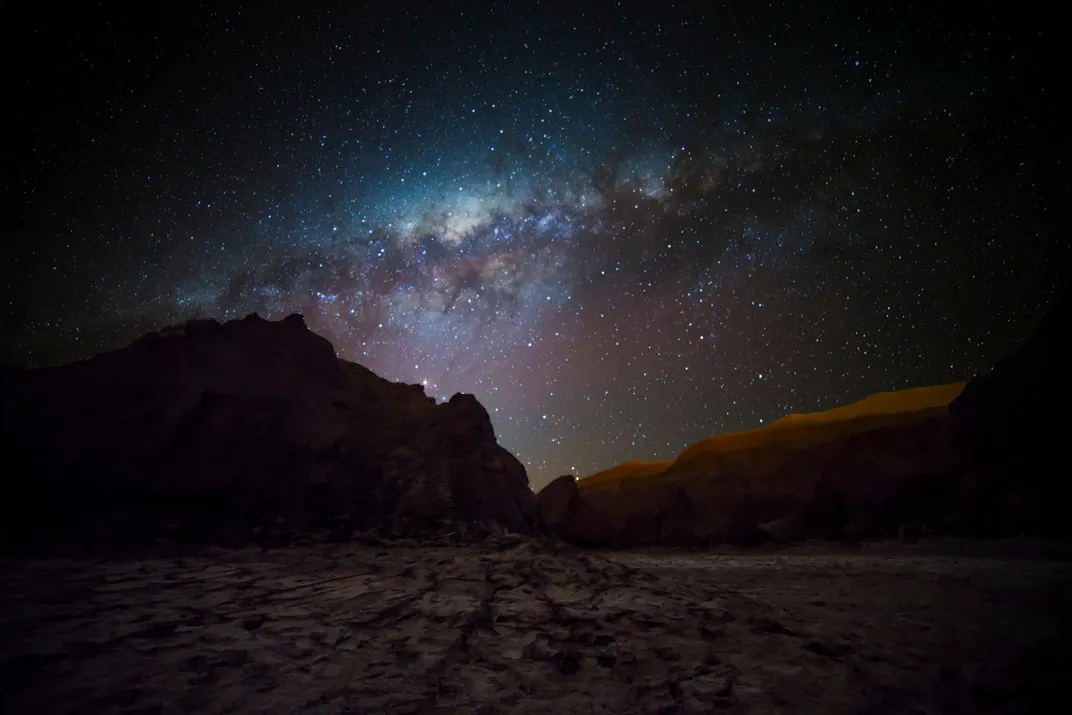
If you’re star trekking in Chile, it’s good to know that most professional observatories are open for tourists one day each week, usually on Saturdays. Check out their schedules in advance to prevent disappointment—the drive from La Serena to La Silla may take almost two hours, and the curvy mountain roads can be treacherous. I once got my four-wheel-drive pickup truck in a spin while descending the gravel road from Las Campanas Observatory, a scary ride I hope never to repeat. Also, dress warm (it can be extremely windy on the summits), wear sunglasses and apply loads of sunblock.
Most professional observatories are open to visitors only during daytime hours. If you’re after a nighttime experience, the region east of La Serena—especially Valle de Elqui—is also home to a growing number of tourist observatories. The oldest is Mamalluca Observatory, some six miles northwest of the town of Vicuña, which opened in 1998. Here amateur astronomers give tours and introductory lectures, and guides point out the constellations and let visitors gaze at stars and planets through a number of small telescopes. Everyone can marvel at the view of star clusters and nebulae through the observatory’s 30-centimeter (12 inches) telescope.
You can look through a 63-centimeter (25 inches) telescope at Pangue Observatory, located ten miles south of Vicuña. At Pangue, astronomy aficionados and astrophotographers can set up their own equipment or lease the observatory’s instruments. Farther south, near the town of Andacollo, is Collowara Observatory, one of the newest tourist facilities in the region. And south of La Serena, on the Combarbalá plain, is Cruz del Sur Observatory, equipped with a number of powerful modern telescopes. Most observatories offer return trips to hotels in Pisco Elqui, Vicuña or Ovalle. Tours can be booked online or through travel agents in town.
I will never forget my first look at the Chilean night sky in May 1987. I was awed by the glorious constellations of Scorpio and the Southern Cross, the star-studded Milky Way with its many star clusters and nebulae, and of course the Large and Small Magellanic Clouds (two companion galaxies to our own Milky Way). Using today’s digital equipment, all of this can be captured on camera. Little wonder that professional astrophotographers have fallen in love with Chile. Some of them have the privilege of being designated photo ambassadors by ESO: They get nighttime access to observatories, and their work is promoted on the ESO website.
Every traveler to Chile interested in what’s beyond our home planet should visit—and photograph—the country’s Norte Grande region. It’s a surrealistic world of arid deserts, endless salt flats, colorful lagoons, geothermal activity and imposing volcanoes. East of the harbor town of Antofagasta, the Atacama Desert looks like a Martian landscape. In fact, this is where planetary scientists tested the early prototypes of their Mars rovers. The alien quality of the terrain makes you feel as if you’re hiking on a forbidding yet magnificent planet orbiting a distant star.
The 45-mile gravel road that took me through the rock-strewn Atacama from Ruta 5 (Chile’s main highway) to Cerro Paranal during my first visit there in 1998 has since been paved, providing much easier access to the ESO’s Very Large Telescope (VLT)—one of the foremost professional astronomical observatories in the world. Here, 8,645 feet above sea level, astronomers enjoy the serene spectacle of sunset above the Pacific Ocean before they switch on the four huge 8.2-meter (323 inches) Unit Telescopes, which are equipped with high-tech cameras and spectrographs that help them unravel the mysteries of the universe. And yes, even this temple of ground-based astronomy is open to visitors only on Saturdays.
A couple hundred miles to the northeast, tucked away between the Cordillera de la Sal mountain range and the Altiplano on the border with Argentina, is the oasis of San Pedro de Atacama. The region was inhabited thousands of years before the Spanish conquistadors built the first adobe houses and a Roman Catholic church in the 17th century—one of the oldest churches in Chile. Today San Pedro is a laid-back village, populated by backpackers and lazy dogs. It serves as the hub for exploratory trips to the surrounding natural wonders, from the nearby Valle de la Luna to the remote El Tatio geyser field.
Even though electric street lighting was introduced in San Pedro some ten years ago, it’s hard to miss the stars at night. A few steps into a dark side road will give you an unobstructed view of the heavens. Don’t be surprised, while you’re sipping a pisco sour in one of the many restaurants in town, to hear American, European or Japanese visitors talk about the big bang, the evolution of galaxies, or the formation of stars and planets. Over the last couple of years, San Pedro has become a second home for the astronomers of the international ALMA observatory.
ALMA (Atacama Large Millimeter/submillimeter Array) is the latest addition to Chile’s professional astronomical facilities. It’s one of the highest (altitude: 16,40 feet) and largest ground-based observatories in the world, with 66 antennas, most of them 12 meters (40 feet) across. The actual observatory, at the Llano de Chajnantor, some 30 miles southeast of San Pedro, is not open to tourists, but on weekends, trips are organized to ALMA’s Operations Support Facility (OSF), where you can visit the control room and take a look at antennas that have been brought down for maintenance. On clear days the OSF offers stunning views of nearby volcanoes and over the Salar de Atacama salt flat. While ALMA studies invisible radiation from distant stars and galaxies, San Pedro also affords many opportunities for old-fashioned stargazing. Some fancy resorts, like Alto Atacama and Explora, have their own private observatories where local guides take you on a tour of the heavens.
But if you really want to immerse yourself in the Chilean night sky, I strongly recommend a visit to SPACE, which stands for San Pedro de Atacama Celestial Explorations. Here, French astronomer and popularizer Maury and his Chilean wife, Alejandra, welcome you with hot chocolate, warm blankets and entertaining stories about the history of astronomy before they take you to their impressive telescope park.
It was here that I got my first look at the globular cluster Omega Centauri. I marveled at the clouds of Jupiter, the rings of Saturn, binary stars, softly glowing nebulae, glittering groups of newborn stars and distant galaxies. Suddenly the world beneath my feet turned into an inconspicuous speck of dust in a vast, incredibly beautiful universe. As the famous American astronomer Carl Sagan once said: “Astronomy is a humbling and character-building experience.” The Chilean night sky touches your deepest self.
For professional astronomers, Chile will remain the window to the universe for many years to come. On Cerro Las Campanas, plans are in place to build the Giant Magellan Telescope, featuring six 8.4-meter (330 inches) mirrors on a single mount. Meanwhile, the European Southern Observatory has chosen Cerro Armazonas, close to Paranal, as the site for the future European Extremely Large Telescope (E-ELT). This monster instrument—which would be the largest optical/near-infrared telescope ever built—will have a 39-meter (128 feet) mirror consisting of hundreds of individual hexagonal segments. It is expected to revolutionize astronomy, and it may be able to detect oxygen and methane—signs of potential life—in the atmospheres of Earthlike planets orbiting nearby stars.
In 2012 I drove the bumpy trail to the summit of Armazonas, and took a small stone for a souvenir. Two years later the mountaintop was flattened by dynamite to create a platform for the E-ELT. One day I hope to return, to see the giant European eye on the sky in its full glory. But well before the telescope’s “first light,” Chile will beckon me again, to witness the wonder of a total solar eclipse, both in July 2019 and in December 2020.
I have to admit I’m hooked. Hooked by the cosmos, as seen and experienced from the astronomical paradise of Chile. You’ll understand when you go there and see for yourself. Who knows, one day we may run into each other and enjoy the view together.
Get the latest Travel & Culture stories in your inbox.
Govert Schilling | READ MORE
Govert Schilling is the prize-winning author of dozens of popular astronomy books. He writes about astronomy and space science for newspapers and magazines from his hometown of Amersfoort, the Netherlands.
Cerro Tololo
Cerro Tololo Inter-American Observatory is home to many NOAO telescopes. Las Cumbres Observatory deployed a full node of three 1-meter telescopes at Cerro Tololo during October 2012 . We also have two 0.4-meter telescopes at this site.
For more information about the site, check out the Cerro Tololo Inter-American Observatory website.

- +56 2 2570 8620
- Contact us!
Tololo Observatory Hill
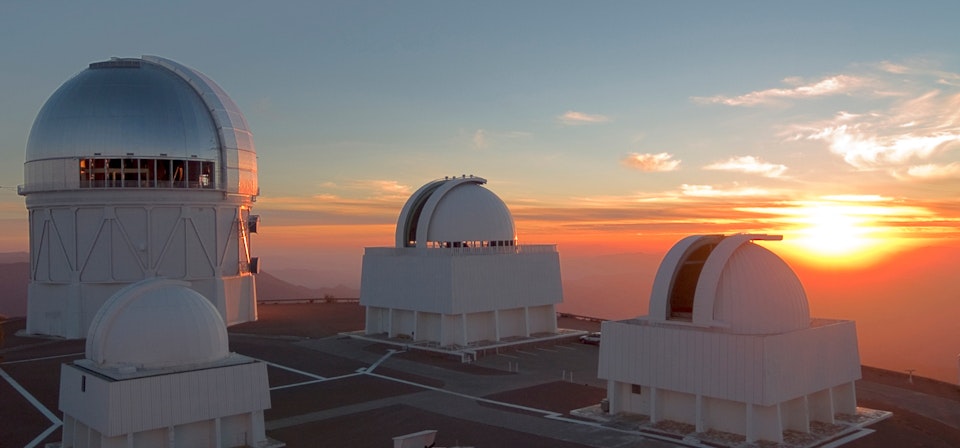
Nearby tourist attractions
Know tololo observatory hill, información del destino:.
High technology instruments.
All year long.
Photography.
Semiarid. Arid in the north and mild in the south. The shore temperatures are homogeneuos, meanwhile in the interior the temperature oscillates between day and night time. Rain during winter season.
Outdoor activities.
Anywhere-La Serena: Land route, by Panamericana Highway north (473 kilometer) Santiago, Arica, Iquique, Antofagasta, Copiapo-La Serena: Airway. La Serena-Cerro Tololo Astronomycal Observatory: Land route, by Internacional Route Gabriela Mistral CH-41.
La Virgen Hill, El Molle, La Laguna Dam, Gualliuaica, Monte Grande, Cerro Mamalluca Astronomical Observatory, Cerro Tololo Astronomical Observatory, Paihuano, Cochiguaz Valley, Elqui River Valley, Vicuña.
- Coquimbo - 53 km La Serena - 53 km La Serena y Coquimbo - 53 km Monte Grande - 30 km Ovalle y Parque Nacional Fray Jorge - 60 km Parque Nacional Fray Jorge - 96 km Pisco Elqui - 29 km Playa Morrillos - 54 km Playa Totoralillo - 56 km
- Playas Avenida del Mar - 53 km Termas de Socos - 90 km Tongoy - 66 km Valle de Cochiguaz - 37 km Valle del Elqui - 23 km Valle del Encanto - 80 km Valle del Limarí - 59 km Valle del Río Elqui - 21 km Vicuña - 17 km
Enjoy a full-day tour to the mystical, amazing and inspiring Elqui Valley, with a privileged location in the beginning of the northern desert…

Why book with us?
Best price without complications, best quality guaranteed, passenger service available 24/7, tours and experiences selected by experts, industry leader, 18 years of experience.
noirlab2412 — Photo Release
Dark energy camera spies cometary globule reaching for the stars, dark energy camera captures the red glow of a cosmic ‘hand’ emerging from within the gum nebula.
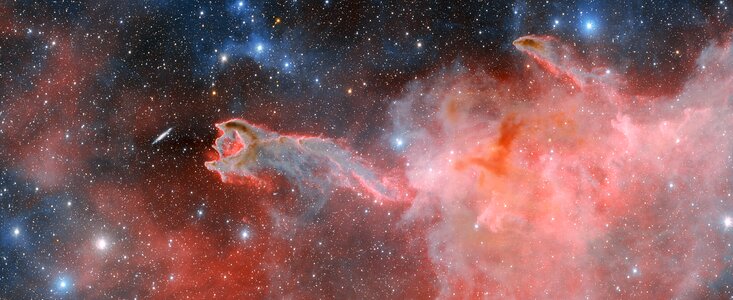
The dark, dusty cometary globule known as CG 4 is spotlighted in this image from the Department of Energy-fabricated Dark Energy Camera mounted on the U.S. National Science Foundation Víctor M. Blanco 4-meter Telescope at Cerro Tololo Inter-American Observatory, a Program of NSF NOIRLab. How these hard-to-detect clouds get their distinctive structure is still unclear, but astronomers speculate that it’s a consequence of the hot, massive stars that surround them.
About 1300 light-years away, in the constellation Puppis, a ghostly hand appears to be emerging from the interstellar medium and reaching out into the cosmos. This cloudy, ominous structure is CG 4 , a cometary globule that has been given the nickname ‘God’s Hand’. CG 4 is one of many cometary globules present within the Milky Way, and how these objects get their distinctive form is still a matter of debate among astronomers.
Cometary globules are a subclass of the dark nebulae known as Bok globules — isolated clouds of dense cosmic gas and dust surrounded by hot, ionized material. When these clouds exhibit stripping of material that results in an extended tail, they are referred to as cometary globules because of their vague resemblance to a comet, though they have nothing in common. The features that classify CG 4 as a cometary globule are hard to miss in this image captured with the Department of Energy-fabricated Dark Energy Camera ( DECam ) mounted on the U.S. National Science Foundation Víctor M. Blanco 4-meter Telescope at Cerro Tololo Inter-American Observatory ( CTIO ), a Program of NSF NOIRLab. Its dusty head, which has a diameter of 1.5 light-years, and its long, faint tail, which is about eight light-years long, make CG 4 a comparatively small Bok globule, a general characteristic of cometary globules.
First recognized in 1976 from pictures taken with the UK Schmidt Telescope in Australia, cometary globules went undetected by astronomers for a long time because they are so faint. Their tails, shrouded in dark stellar dust, block most light from passing through. But with its special Hydrogen-alpha filter [1] , DECam can pick up the faint red glow of ionized hydrogen present within CG 4’s head and around its outer rim. This light is produced when hydrogen becomes excited after being bombarded by radiation from nearby hot, massive stars.
The intense radiation generated by these neighboring massive stars, however, is gradually destroying the head of the globule and sweeping away the tiny particles that scatter the starlight. Still, the dusty cloud of CG 4 contains enough gas to feed the active formation of several new, Sun-sized stars.
While astronomers have observed these structures throughout the Milky Way, the overwhelming majority of them, including CG 4, are found within a huge patch of glowing gas called the Gum Nebula . Believed to be the expanding remains of a supernova that took place about a million years ago, the Gum Nebula is currently known to contain at least 31 cometary globules in addition to CG 4.
The mechanism by which these comet-like objects get their distinct shape is not entirely known, but astronomers have developed two main ideas about their origins. The first idea is that they could have originally been spherical nebulae — like the well-known Ring Nebula — which were then disrupted by a nearby supernova explosion, possibly the original explosion that created the Gum Nebula.
The second idea is that cometary globules are shaped by a combination of stellar winds and radiation pressure from nearby hot, massive stars. In fact, all of the cometary globules found within the Gum Nebula appear to have tails pointing away from the center of the nebula, which is where the Vela Supernova Remnant and Vela Pulsar are located. The Vela Pulsar is a rapidly spinning neutron star that was formed when a massive star collapsed, and it’s possible that its stellar winds and radiation pressure are shaping the nearby globules.
Also in this image it looks as if CG 4 is about to devour the edge-on spiral galaxy ESO 257-19 (PGC 21338), which appears to be placed so defenselessly in front of it. But in reality, this galaxy is more than a hundred million light-years beyond CG 4 and only appears to be close because of a chance alignment.
[1] At 62 cm (25 inches) in diameter, DECam’s narrow-band filters are some of the largest in operation anywhere. There are currently 11, centered on different wavelengths of interest, with 3 more being fabricated. Making narrow-band filters of this size that work in wide-field instruments like DECam is a significant technical challenge.
More information
NSF NOIRLab (U.S. National Science Foundation National Optical-Infrared Astronomy Research Laboratory), the U.S. center for ground-based optical-infrared astronomy, operates the International Gemini Observatory (a facility of NSF , NRC–Canada , ANID–Chile , MCTIC–Brazil , MINCyT–Argentina , and KASI–Republic of Korea ), Kitt Peak National Observatory ( KPNO ), Cerro Tololo Inter-American Observatory ( CTIO ), the Community Science and Data Center ( CSDC ), and Vera C. Rubin Observatory (operated in cooperation with the Department of Energy ’s SLAC National Accelerator Laboratory). It is managed by the Association of Universities for Research in Astronomy ( AURA ) under a cooperative agreement with NSF and is headquartered in Tucson, Arizona. The astronomical community is honored to have the opportunity to conduct astronomical research on I’oligam Du’ag (Kitt Peak) in Arizona, on Maunakea in Hawai‘i, and on Cerro Tololo and Cerro Pachón in Chile. We recognize and acknowledge the very significant cultural role and reverence that these sites have to the Tohono O’odham Nation, to the Native Hawaiian community, and to the local communities in Chile, respectively.
- Explore CG 4 in more detail
- Photos of the Víctor M. Blanco 4-meter Telescope
- Videos of the Víctor M. Blanco 4-meter Telescope
- Photos of DECam
- Images taken by DECam
- Check out other NOIRLab Photo Releases
Josie Fenske Jr. Public Information Officer NSF NOIRLab Email: [email protected]
About the Release


IMAGES
VIDEO
COMMENTS
At Cerro Tololo Inter-American Observatory the tours are limited to 42 visitors per tour. The minimum number of confirmed visitors for a scheduled tour is four people. If the minimum number of people has not been met, (or the number has fallen below the minimum due to guests canceling) the day before the scheduled visit, it will be canceled.
Cerro Tololo Inter-American Observatory (CTIO), a program of the NSF NOIRLab, is a complex of astronomical telescopes and instruments located approximately 500km (310 miles) north of Santiago, and 80 km (50 miles) to the east of La Serena, Chile, at an altitude of 2200 meters (7200 feet). ... Daytime guided tours of the facilities on Cerro ...
Tours Excursions IV Region of Coquimbo. The Cerro Tololo Interamerican Observatory (CTIO) is a complex of telescopes and astronomic instruments located in the Elqui Valley at an altitude of 2.200 above sea level. It is operated by AURA, the Association of Universities for the Research in Astronomy, in cooperation with Universidad de Chile and ...
Operated by the Tucson-based Association of Universities for Research in Astronomy (AURA, a group of about 25 institutions, including the Universidad de Chile), Tololo has an enormous 4m telescope. Free bilingual tours take place on Saturday only; make reservations at least one month ahead in high season. Two-hour tours are held at 9am and 1pm.
The Cerro Tololo Inter-American Observatory (CTIO) is an astronomical observatory located on the summit of Mt.Cerro Tololo in the Coquimbo Region of northern Chile, with additional facilities located on Mt. Cerro Pachón about 10 kilometres (6.2 mi) to the southeast. It is approximately 80 kilometres (50 mi) east of La Serena, where support facilities are located.
CTIO is located on Cerro Tololo which is a rather long dusty ride either on a bus or by car. The winding road after leaving Vicuna is well worth eating the dust and getting queasy from too many switchback corners! ... Great observatory, awful tour. Mar 2014 • Couples. ... Cerro Tololo Inter-American Observatory - All You Need to Know BEFORE ...
Cerro Tololo Inter-American Observatory. Situated about 30 miles inland of La Serena in Chile, on a 7,000 foot mountain in the Andes, this observatory is home to several telescopes. The most famous is the Victor Blanco 4-meter (158 inch) reflector which has been at the cutting edge of astronomy since the mid-1970s.
A dedicated 570-megapixel camera attached to the four-meter (157 inches) Blanco Telescope at Cerro Tololo Inter-American Observatory is charting dark matter and dark energy—two mysterious ...
Our free public visits to our sites are now open. Cerro Tololo Inter-American Observatory (CTIO), a program of the NOIRLab, is a complex of astronomical telescopes and instruments located approximately 500 km (310 miles) north of Santiago, and 80 km (50 miles) to the east of La Serena, Chile, at an altitude of 2200 meters (7200 feet).
Perched at 2,200 meters (7,200 feet), Cerro Tololo Observatory runs free tours of its two principal telescopes on Saturdays. During January and February, priority is given to nonspecialist ...
When is Totality at La Silla Observatory? July 2, 2019 at 16:39pm (1 minute 48 seconds) 2 — National Optical Astronomy Observatory, Cerro Tololo Inter-American Observatory (CTIO) (Totality ...
Cerro Tololo Inter-American Observatory is home to many NOAO telescopes. Las Cumbres Observatory deployed a full node of three 1-meter telescopes at Cerro Tololo during October 2012.. We also have two 0.4-meter telescopes at this site.. For more information about the site, check out the Cerro Tololo Inter-American Observatory website.
Know Tololo Observatory Hill. Cerro Tololo Astronomical Observatory is an investigation center located 2200 meters above sea level. It has seven high technology optical telescopies. It´s operated by the Asociation of Universities for the Research in Astronomy Incorporation (AURA), in asociation with the National Optical Astronomy Observatories ...
The Cerro Tololo Inter-American Observatory (CTIO) is an astronomical observatory located on the summit of Mt.Cerro Tololo in the Coquimbo Region of northern Chile, with additional facilities located on Mt. Cerro Pachón about 10 kilometres (6.2 mi) to the southeast. It is approximately 80 kilometres (50 mi) east of La Serena, where support facilities are located. The site was identified by a ...
Cerro Tololo Inter-American Observatory (CTIO), La Serena, Chile. 7,310 likes · 190 were here. El Observatorio Interamericano de Cerro Tololo (CTIO) es un programa de NOIRLab de NSF....
This article was most recently revised and updated by Amy Tikkanen. Cerro Tololo Inter-American Observatory (CTIO), astronomical observatory founded in 1965 in Chile as the southern branch of the Kitt Peak National Observatory. It is located on top of two mountains, Cerro Tololo, which is 7,200 feet (2,200 metres) high, and Cerro Pachon, which ...
Días de visitas y límite de personas. Horarios y Puntos de Encuentro. Cerro Tololo, Chile. Todos los sábados. 4-42 visitantes por tour. Sábado 9:00 am. Sábado 1:00 pm. Punto de Encuentro y acceso a bus: Garita de Acceso al Observatorio, Ruta 41/D-317, Km 50, La Serena, Chile.
Desde sus primeras observaciones en 1965, Cerro Tololo ha constituido la plataforma principal para la investigación astronómica estadounidense de los cielos australes. El Observatorio Interamericano Cerro Tololo (CTIO), un Programa de NOIRLab de NSF, es un complejo de telescopios e instrumentos astronómicos ubicados aproximadamente a 500 km ...
The dark, dusty cometary globule known as CG 4 is spotlighted in this image from the Department of Energy-fabricated Dark Energy Camera mounted on the U.S. National Science Foundation Víctor M. Blanco 4-meter Telescope at Cerro Tololo Inter-American Observatory, a Program of NSF NOIRLab. How these hard-to-detect clouds get their distinctive structure is still unclear, but astronomers ...